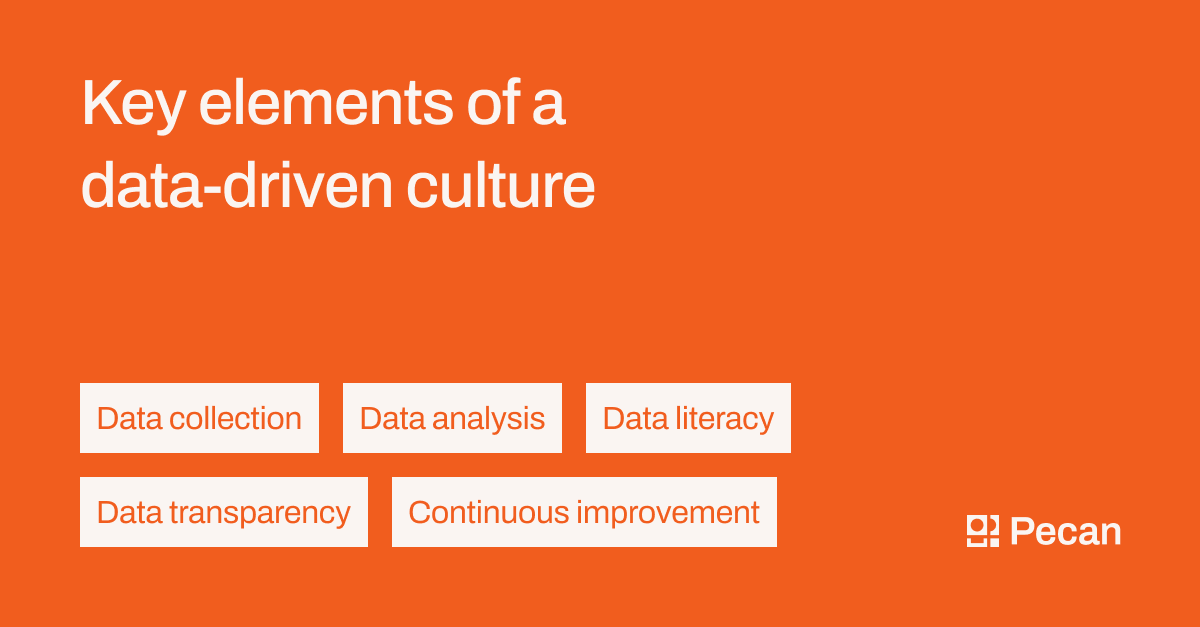In a nutshell:
- A data-driven culture values and relies on data to inform decision-making processes.
- Key elements of a data-driven culture include data collection, analysis, literacy, transparency, and continuous improvement.
- Two benefits of a data-driven culture are improved decision-making (as seen with Netflix) and better customer experience (as seen with Amazon).
- Netflix uses data to identify trends, understand audience preferences, and make strategic decisions about content.
- Amazon leverages data to personalize the customer experience, optimize logistics, and drive product-led growth.
As sarcastic as he was brilliant, W. Edwards Deming, an American statistician and management consultant, once said, “In God we trust. All others must bring data.”
Deming was emphasizing the critical role data should play in evaluating an organization’s performance. He championed the use of data measurement and analysis to make informed business decisions. Sixty years later, you’d be hard-pressed to find a successful business that doesn’t.
Indeed, today’s tech giants wouldn’t be where they are today were it not for their full appreciation and embrace of data and all its possibilities. Leveraging data to make decisions has helped them conquer nearly every corner of the tech market, be it search, social networking, shopping, entertainment.
And none of it happened by accident. Whether you’re talking about Amazon, Netflix, Facebook, or Google, a data-driven culture lies at the heart of who they are and every decision they make – from how they operate to how they interact with customers.
In this article, we’ll explore what it means to have a “data-driven culture,” and use examples from these companies to illustrate the benefits of such a culture.
And since you may not be blessed with the organizational influence of a CEO, we’ll try to bring these lessons back down to earth – so you can start paving your own path toward a more data-driven future. But first…
What is a data-driven culture?
A data-driven culture is a workplace culture that values and relies on data to inform decision-making processes. The people belonging to this culture use data to identify trends, uncover insights, and make decisions that are grounded in evidence rather than speculation, instinct, or best practices.
Here’s a short list of some key elements that all data-driven cultures have in common:
Data collection: Data is consistently being collected. There is a commitment to tracking and recording relevant data points, as well as ensuring that data is clean, organized, accurate, and easily accessible.
Data analysis: Once collected, data is analyzed in order to extract meaningful insights. This involves the use of tools and techniques to identify patterns, trends, and correlations in the data – and even make predictions.
Data literacy: All employees with a strategic role will have a basic understanding of data, how to read and interpret it, and how to use it to inform decision-making.
Data transparency: Data is shared openly and transparently. This means all employees have access to relevant data, and that decisions are made based on the best available insights. The data is allowed to speak for itself.
Continuous improvement: Data is constantly used to identify areas for improvement, set goals, and monitor progress over time.
Data-driven company cultures share key characteristics.
Benefits of a Data-Driven Culture
If your manager asked you to brainstorm all the different ways that data could help your organization improve performance, increase revenue or reduce costs, you would probably come up with dozens of ideas in a matter of minutes.
But for the purposes of this article, we’ll dive deep into two particular benefits – and how two familiar tech giants have achieved tremendous success, due in part to their brilliant execution of a data-driven approach.
1. Improved decision-making: Netflix
Organizations make decisions in an infinite number of ways, and some decisions are more impactful than others. That’s because they guide everything from innovation to resource allocation, from risk management to overall strategic direction.
In the case of Netflix, one particular set of decisions determines how they spend $7 billion each year – that’s the amount they’re forecasted to spend on original content in 2023 (Statista 2022). And it doesn’t even include the $15 to $20 billion they shell out each year for licensing costs.
A single yes-or-no decision can have an immediate impact of tens of millions of dollars. So when Netflix chooses to greenlight a particular project, that decision doesn’t happen without thorough analytical research.
For that reason (among others), Netflix has cultivated a culture that places an extremely high value on data and data practitioners. They use a data-driven approach to identify opportunities for new original content, to understand audience preferences and trends, and to make strategic decisions about which projects to invest in.
Netflix’s goal is to leverage data analytics and insights so it can produce content that resonates with its subscribers and drives engagement and retention. Here are some examples to show what that means::
- Viewer data: Netflix analyzes viewing habits, preferences, and engagement in order to identify trends and insights (e.g., which genres are most popular, which actors or directors are most successful, or which types of storylines resonate with audiences).
- Social media data: Netflix monitors social media to understand what audiences are saying about its content and which topics or themes are generating buzz. This helps them identify opportunities to create new content that aligns with audience interests and preferences.
- Test screenings: Netflix conducts screenings with test audiences to gather feedback on pilot episodes and early productions of its original content. This helps them identify which shows or movies are likely to be successful before investing in full production.
- Algorithmic recommendations: Netflix uses its proprietary recommendation engine to suggest content to viewers based on their viewing history and preferences. This data also helps the company identify which types of content are likely to be successful with specific segments of its subscriber base.
Of course, no one is claiming that data analysis will always produce the best business decision. To see evidence of that, you just need to log into Netflix and watch “Bright” or “The Stand In.”
So what can you take away from this?
The decisions of your organization may not be as high-stakes as those made by Netflix, but they certainly have a tremendous impact – whether it’s on how you sell to customers, how you prioritize and design product features, or whether you can make it to your next funding round.
As you aspire towards more data-driven decision-making, here are some questions you can begin to answer:
- Which metrics do you – or should you – track in order to measure company success?
- How can you use data to identify trends and patterns in your customers’ behavior, preferences, and needs?
- Which products, services, or features are the most profitable or popular, and which are not?
- How can you use data to reduce customer acquisition costs, optimize marketing spend, and improve the lifetime value of your customers?
- Are there any inefficiencies in your business processes, and how can you streamline them?
- How can you use data to forecast revenue and costs, and make informed decisions accordingly?
2. Better customer experience: Amazon
In today’s competitive marketplace, providing a great customer experience is more important than ever. It can impact every part of your business’s success, from brand reputation to customer acquisition to retention and loyalty.
This is one reason why many startups have elevated customer-centricity or customer satisfaction as a core value. When they explain it to their employees, they inevitably cite the example of Amazon, whose mission is “to be Earth’s most customer-centric company,” and whose founder, Jeff Bezos, is known for saying, “The most important single thing is to focus obsessively on the customer.”
Amazon is as much a data company as it is an e-commerce company, owing to the amazing number of ways it leverages data to provide a world-class customer experience. This data-driven approach is also a huge driver behind the company’s leadership in innovation and efficiency.
A “prime” example (see what we did there?) of this is how Amazon analyzes each customer’s behavior and purchase history, and then uses that data to tailor the customer’s experience and recommend products that they’re likely to be interested in.
This doesn’t just create a more personalized and efficient customer experience. It also generates an endless stream of upsell and cross-sell opportunities, and greatly contributes to product-led growth – where user acquisition, expansion, conversion, and retention are all driven primarily by the product itself.
And personalized recommendations are just one feature that emerged from Amazon’s data-driven culture. Here are a few more…
- One-click ordering: This patented process stores customers’ payment and shipping information, making it easy for customers to place an order with just one click.
- Customer reviews: Customers can leave reviews on products they’ve purchased, thereby improving product recommendations and helping other customers make informed purchasing decisions.
- Prime Delivery: Amazon uses data to optimize its logistics and delivery network to ensure that Prime members receive their orders as quickly as possible – and that the supply chain remains extremely efficient.
So what can you take away from this?
Your company may not be Amazon, but if you belong to a data-driven culture, you can start brainstorming all sorts of ways to provide a better customer experience through the use of data.
Here are some questions to help you get started:
- What data do you currently collect from customers?
- How can you use that data to personalize the customer experience and provide more relevant content, products, or services?
- How can you use that data to improve the customer journey, from initial contact to ongoing engagement?
- How can you use data to identify upselling or cross-selling opportunities?
- What other data could you collect in order to better understand your customers and their needs?
- How can you use data to measure the effectiveness of customer experience initiatives, and to identify and proactively address customer issues or concerns?
Keep learning
Although we’ve only covered two of them here, there are countless benefits to building a data-driven culture. We’ve chosen to illustrate them by taking a look at some of today’s most dominant tech brands.
We hope the example and questions we’ve provided will inspire you to explore some new directions as you begin to cultivate your own data-driven culture.
Start building a data-driven culture now. Sign up for a free trial now and try it yourself, or join us for a personal, one-on-one tour and let us show you how it works.




